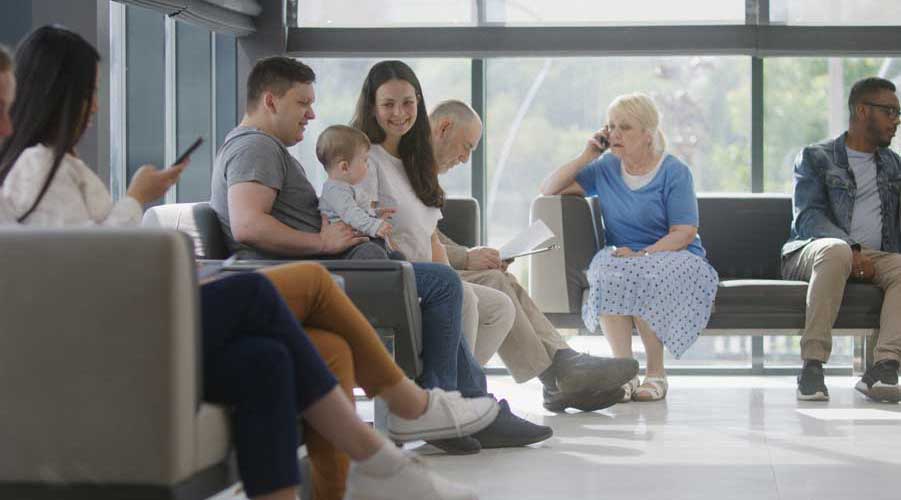
05 Apr Geofencing helps healthcare marketers corral the right audience in the right place
Sound familiar? You’re walking down the street. It starts to rain. And you’ve left your umbrella at home. Your smartphone vibrates. You check it—and there’s a message inviting you to visit the umbrella store across the street to get a 20% discount on umbrellas.
Coincidence? No, geofencing.
Geofencing is an innovative location-based marketing technology that’s ideal for marketers in a variety of fields, including healthcare. Because it gives you the power to precisely target patients, caregivers, and healthcare professionals with personalized ads and deliver them to everyone online on their tablet or phone at a hospital, clinic, doctor’s office, health fair, medical conference, or other location.
What is geofencing?
Imagine setting up an invisible, virtual, digital “fence” around a specific geographic location. And then delivering targeted healthcare campaigns to people using a mobile device who cross the fence. That’s geofencing.
Geofencing in healthcare uses GPS, Wi-Fi, radio frequency identification (RFID), or cellular data to trigger personalized messages—push notifications, text messages, social media ads—about a product or service directly to people online within a defined physical area.
And it can do so either in real-time or later, up to 30 days, to help keep your brand top of mind.
Let’s say you are launching a new AI-powered echocardiography technology at the ASE (American Society of Echocardiography). To target this valuable audience, you geofence the convention center, participating hotels, and other relevant locations and deliver customized ads about your product, increasing awareness and driving traffic to your booth.
Plus, with geofencing, ads continue to be served to this audience 30 days after the conclusion of the conference.
Deliver the right message to the right audience at the right time and place
Geofencing allows you to reach HCPs and patients when and where they may be most receptive to your message.
For example, you can target specific doctors’ offices based on NPI (National Provider Identifier), CPT (Current Procedural Terminology), and HCPCS (Healthcare Common Procedure Coding System) codes and deliver your ads to patients while they are in the waiting room.
Is geofencing effective?
You bet it is. Studies reveal that geofencing campaigns:
• Have twice the click-through rate (CTR) compared to industry standards
• Are up to 10x more effective than email campaigns and other marketing strategies
• Significantly increase booth traffic at conventions and foot traffic to brick-and-mortar locations
The benefits of geofencing
In addition to allowing you to hyper-target your audience and deliver relevant, customized messages, geofencing offers many other advantages:
Ensures greater cost-effectiveness
Traditional advertising—TV commercials or print ads—casts a wider net but can be costly. Even more, it often reaches audiences that may not have an interest in your product or service. With geofencing, you’re using marketing dollars specifically to reach high-intent consumers.
Enhances the audience experience
Timely, tailored messaging helps improve the audience’s buying journey, which increases engagement, conversions, and sales.
Delivers measurable metrics
Traditional advertising can sometimes be difficult to quantify. With geofencing, metrics are available in real time. So you can quickly track the effectiveness of your campaign and make any changes if needed.
Provides audience insights
Geofencing allows you to collect valuable data to better understand your audience, which you can use to refine your marketing strategies and increase conversions and sales.
Improves campaign performance
By increasing engagement, conversion, and brand awareness, you can expect improved performance from your marketing campaigns.
And now, a word about patient privacy and data security
The good news: geofencing complies with HIPAA (Health Insurance Portability and Accountability Act) because it targets patients’ location data rather than personal health information.
However, location data is classified as personal information (name, address, phone number, email address) by the California Consumer Privacy Act (CCPA) and General Data Protection Regulation (GDPR).
Healthcare marketers must ensure transparency in the use and collection of data, obtain proper user consent, and provide the option to opt out.
Ready to geofence?
Contact Bryant Brown Healthcare. We can help articulate your goals, identify your audience, create geofences around relevant targets, and craft compelling messages that connect with your audience. We’ll then analyze the data and optimize the campaign to ensure its success!
See how we can help
